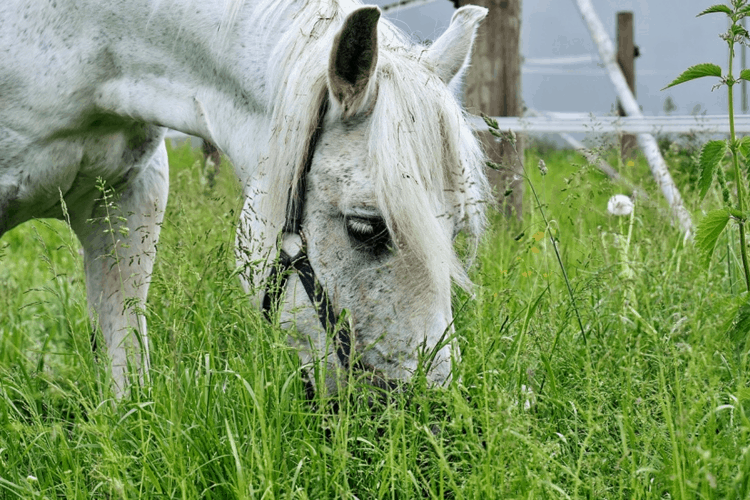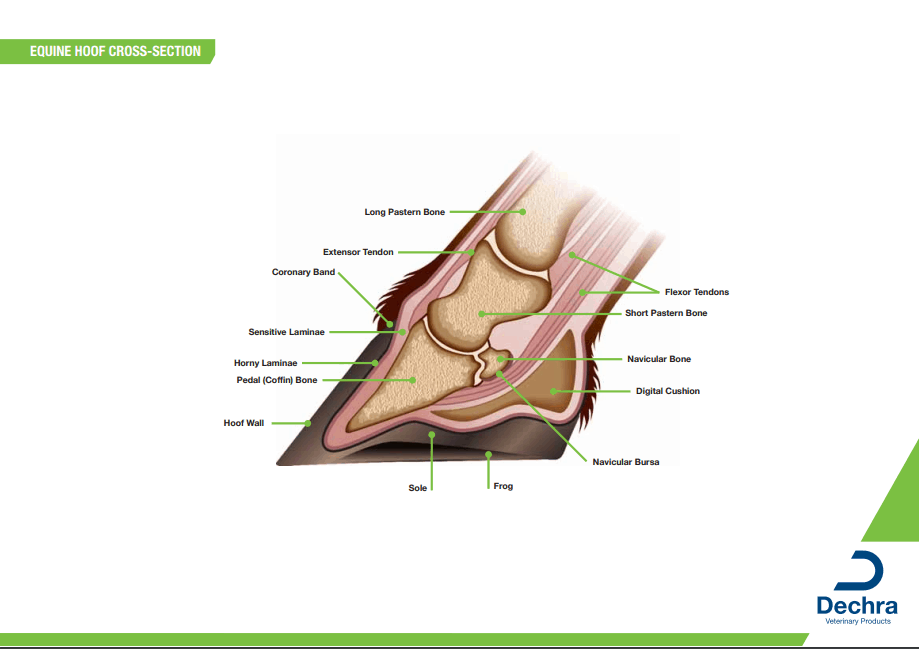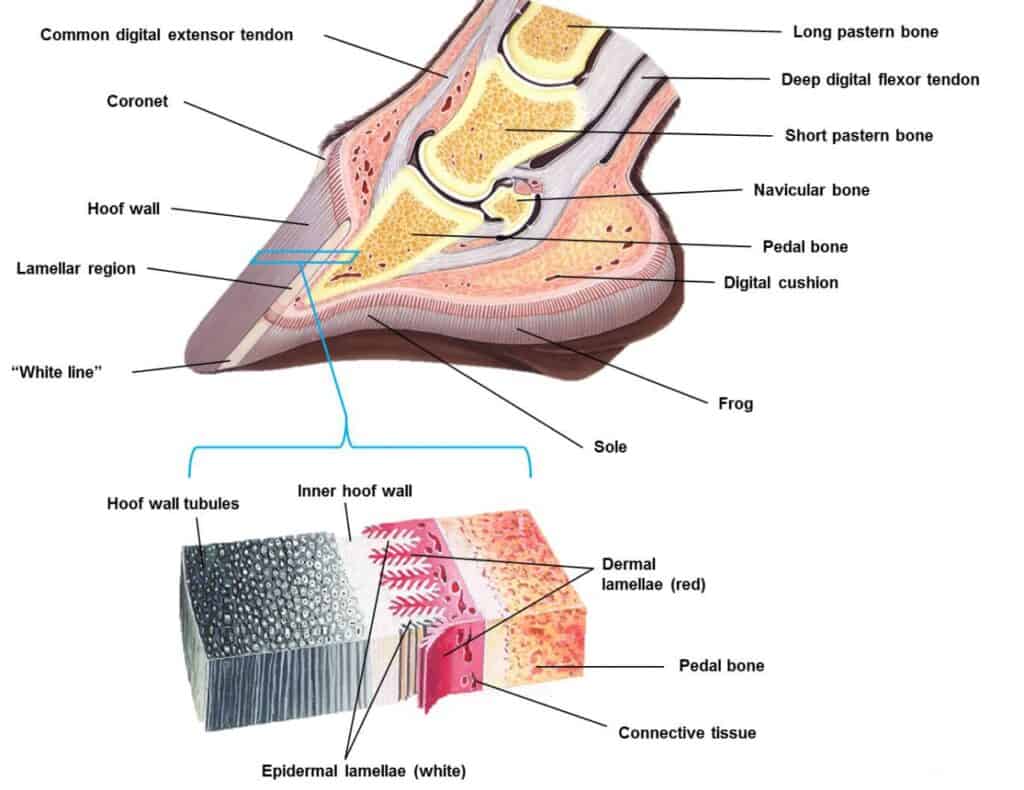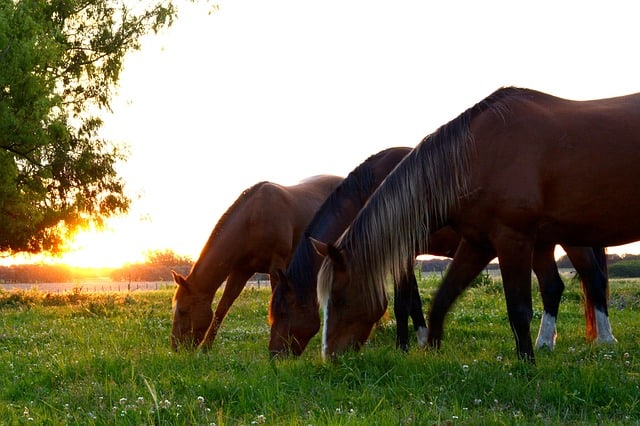
When spring and summer really get underway the Grass begins to surge and horses are being let out for longer periods, there is one word that echoes throughout Equestrian Circles, Laminitis.
Laminitis is an inflammation of the Laminae, which are structures responsible for cushion and support of the pedal bone within the horse’s hoof.
When we hear the word, Laminitis, we immediately think of Fat Ponies that have escaped into lush pasture and gorged themselves. However, this is only one of the causes of this disease which can prove to be a nightmare for horse owners.
Let’s explore, what Laminitis is, its symptoms and what effects it has on the horse.
Laminitis The Science Bit.

As previously said, Laminitis is an inflammation of the Laminae of a Horses foot. The Horse’s Hoof, is made up of hard outer wall, and sole, within which are the bones and soft tissues. The Inner layer of the hoof wall is made up of Epidermal or Insensitive Laminae, which interlock with the Dermal layer or sensitive laminae. The Role of the laminae is to suspend the pedal bone within the wall of the hoof and to provide, cushion, support and protection to the bones of the hoof during movement.

However, if the hoof becomes inflamed, this can cause damage to these delicate structures. Once this happens, the interlocking arrangement of the Insensitive and Sensitive Laminae can begin to weaken. When this occurs, even with normal movement, these structures can start to separate allowing the pedal bone/coffin bone to begin to rotate downwards through the sole of the foot. This can be further aggravated by the pull of deep flexor tendon, which attaches to the back of the pedal bone. Once the Laminae are weakened and start to separate, in severe cases the Deep Flexor Tendon, can quite literally pull the pedal bone, through the sole of the foot.
When there is movement or displacement of the Pedal bone, either through rotation or sinking due to significant damage to the laminae, the condition is known as Founder.
What Causes Laminitis?
Some of the Common Causes are:
Excess of Carbohydrate can occur with grain, lush pasture or stressed grass, such as grass after frost etc. The current thinking is that when a horse has an excess of carbohydrates such as sugar, starch or fructan, it may not be able to completely digest these in the foregut. Once the of sugars pass into the hindgut, they begin to ferment in the caecum. This has an adverse affect on the balance of flora in the gut, killing off the good bacteria, resulting in the production of endotoxins and exotoxins, which can manage to find their way into the bloodstream through the gut wall. This will cause an inflammatory response throughout the horse’s body, however, when this occurs in the feet, the swelling has nowhere to expand and therefore causes damage to the delicate laminae, resulting in Laminitis.

Nitrogen Overload, or Excess Clover in the grass, can have a similar toxic effect on the horse if eaten in excess, causing laminitis.
Colic – Severe Colic, can also produce toxins, that can cause laminitis.
Retained Placenta or any bacterial infection which is left untreated can lead to the production of endotoxins causing laminitis.
Insulin Resistance – horses that are insulin resistant are those that tend to gain weight easily. It is thought that such animals can develop laminitis in the most benign situations and should be kept off grass and fed a diet of hay and water.
Cushings Syndrome and Metabolic Disorders such as Equine Metabolic Syndrome, can mean such horses that have a greater susceptibility to laminitis.
Corticosteroids have been linked to the onset of laminitis in some horses.
Excessive Roadwork coupled with toes being allowed to grow too long, can lead to laminitis.
Stress caused by long journeys in a trailer or horsebox.
Excessive Weight bearing on one leg ,as a result of another injury, such as a fracture.
Symptoms of Laminitis.
- Horse’s front feet are usually very hot, but laminitis can affect all 4 feet.
- Laminitic Stance is characterised by the animal leaning back taking weight off the front feet.
- Visibly very lame and finding it difficult to move.
- Strong Digital Pulse is present in affected limbs.
- If the horse has had repeated episodes there can be ridges present on the wall of the hoof, and there also may be a broken hoof axis, which is caused by displacement of the pedal bone.
- Horse is usually very sensitive when tested with a hoof tester
- X-Ray may be necessary to determine if there has been significant rotation of the pedal bone.
Treatment for Laminitis.
- Remove the horse from the field.
- In the early stages of an attack, cold hosing or icing is vitally important to reduce inflammation.
- The vet may prescribe anti-inflammatories such as bute to control of pain and inflammation.
- Sedation such as ACP will help lower Blood Pressure in the early stages and also help to relax the animal and minimize damage.
- The animal should have controlled rations with hay and water with a deep comfortable bed.
- Exercise must be controlled in the early stages.
- The use of a vasoperiferal dilators has been indicated once the attack has subsided as they are thought to help to restore normal blood flow to the hoof, to help with healing.
- X-Rays will help to show how significant the rotation of the pedal bone is, which is beneficial to the farrier who will have an important job using Corrective shoeing, with an aim to realign and support the pedal bone.
- As the Deep Flexor Tendon exerts quite a pull on the pedal bone, a raised heel is often used on the shoe to counteract this.
- The corrective trimming and shoeing to realign and bring the pedal bone back into the correct position can take approximately 1 year and this must be done at regular intervals if any significant change is to be made.
Other Forms of Treatment for Severe Cases of Laminitis
- Dorsal Hoof Wall Resection – This is only performed with experienced vets and farriers, it entails a cutting of the front of the wall of the hoof with the aim to restore normal laminae growth and realignment of the pedal bone.
- Cornonary Grooving – This is where some of the hoof wall is removed just below the coronary band with the aim to improve the wall growth.
- Deep Digital Flexor Tenotomy – This involves cutting into the the Deep Flexor Tendon, with an aim to reduce the pull it has on the pedal bone. This treatment is done by experienced vets and is usually accompanied by corrective shoeing.
- Botulinum Toxin Infusion – This involves the infusion of a Clostridium Botulinum Type A toxin into the Deep Digital Flexor Muscle, it’s aim is to reduce the pull of the Deep Flexor Tendon on the pedal bone. It has not been widely tested yet, but has had some positive results.
Conclusion
Early Diagnosis and Treatment of Laminitis is paramount to the control of the disease. So call your vet as soon as possible, this coupled with correct management could mean everything to the successful treatment of your horse, and the prevention of further attacks.
This article was originally published in the June 2019 Issue of Irish Sport Horse Magazine.
